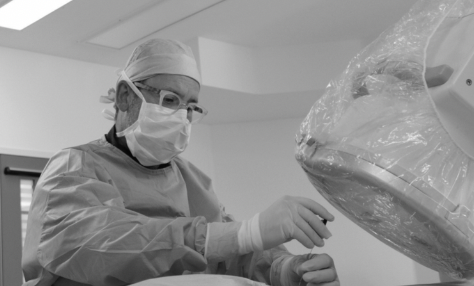DISCOGRAM
The only valid diagnostic procedure for determining if a disc is the pain generator, is a provocative discogram. A discogram is an imaging-guided procedure in which a contrast agent is injected into the inner core of the vertebral disc. You will need to be admitted to hospital as a day patient for this procedure.
HOW DOES IT WORK?
A tube containing a fine needle, called an intravenous cannula, is inserted into the relevant vertebral discs. A small amount of pain relief medication may be used to ensure minimum discomfort. However, it is imperative that the patient still be able to answer questions clearly and precisely during the procedure.
During the procedure, the needle may brush against facet joints behind the spine, which can cause a short term deep, aching pain. Sometimes, the needle may brush against the side of the 'exiting nerve root', which causes a sharp 'electrical' or 'hot' pain to shoot down the leg. Whilst the chances of this occurring are low, you should still inform your doctor if you experience this sort of pain. They will then manipulate the needle away from the nerve to avoid nerve damage.
THE PROCEDURE
The procedure is performed under 'C-arm' fluoroscopic guidance. This is an imaging technique that uses x-rays to enable you doctor to view real-time moving images of an internal structure of the body to increase precision. In this case, it is the vertebral discs. The 'C-arm' simply refers to the shape of the arm on the x-ray machine.
Once the needles are ideally placed, the doctor injections each disc with a radio-opaque dye so that the inside of the disc can be seen. The will also enable them to see if there are any anular tears, which are tears in the tough exterior of your disc. An antibiotic is injected together with the dye.
WHAT DO THE RESULTS MEAN?
This procedure is designed to reproduce the usual 'pain pattern'. A normal, healthy disc will have no pain whatsoever or only a slight feeling or 'pressure' in the back. This is the most common response. The next response that may occur is a small amount of pain that unlike your normal symptoms. It is important to identify the amount of pain and confirm that it is different to your normal pain.
The final outcome that may occur is that the disc injection reproduces the usual pain. It's important that this test clearly establishes pain as close to the usual pain, in character, distribution and intensity. Once the injection pressure is released, the pain usually subsides rapidly. At times, the doctor will inject a small dose of anaesthetic into the disc to see if the pain rapidly eases.
COMPLICATIONS
While these are rare, it is important to understand there's a small risk of developing a disc infection. The risk of this is reduced by a number of precautions that are routinely taken, including:
A modified double needle technique is used, along with a stilleted needle (as opposed to a standard needle), which means it's impossible to carry a tiny piece of skin down into the disc. This used to occur in the past and resulted in a higher risk of infection.
Antibiotics are usually given via the IV cannula and injected into the disc.
There is a risk of causing damage to other structures around the spine, such as the nerve roots. This risk is minimised by the use of live fluoroscopy, and by keeping the patient awake and in communication. The risk of haemorrhage is minimal.
POST PROCEDURE
Following the procedure, it is common to have a transforaminal injection at the most painful level to assist in post procedure pain relief. This injection is a combination of local anaesthetic and long-acting steroid.
You'll then be observed in the recovery ward and discharged from hospital approximately two hours after the procedure.
DISCOGENIC PAIN
Discogenic pain refers to pain from the intervertebral dis, the strong mobile structure forming the major connection between vertebrae. Pain from the discs is the most common cause of chronic low back pain.
Single or repetitive trauma - particularly lifting and twisting - can lead to disc injury. This may weaken the outer disc with a possible radial tear and if this spreads to the internal part of the disc, it will irritate the small nerves located there, producing low back pain.
MORE ABOUT THE PAIN CHART
You should rate your pain between 0 and 10 before your injection, and after for 6 hours, firstly in 30 minute intervals and then hourly intervals. Ratings should be conducted in terms of movements and how you feel doing the things that most aggravate the pain.



